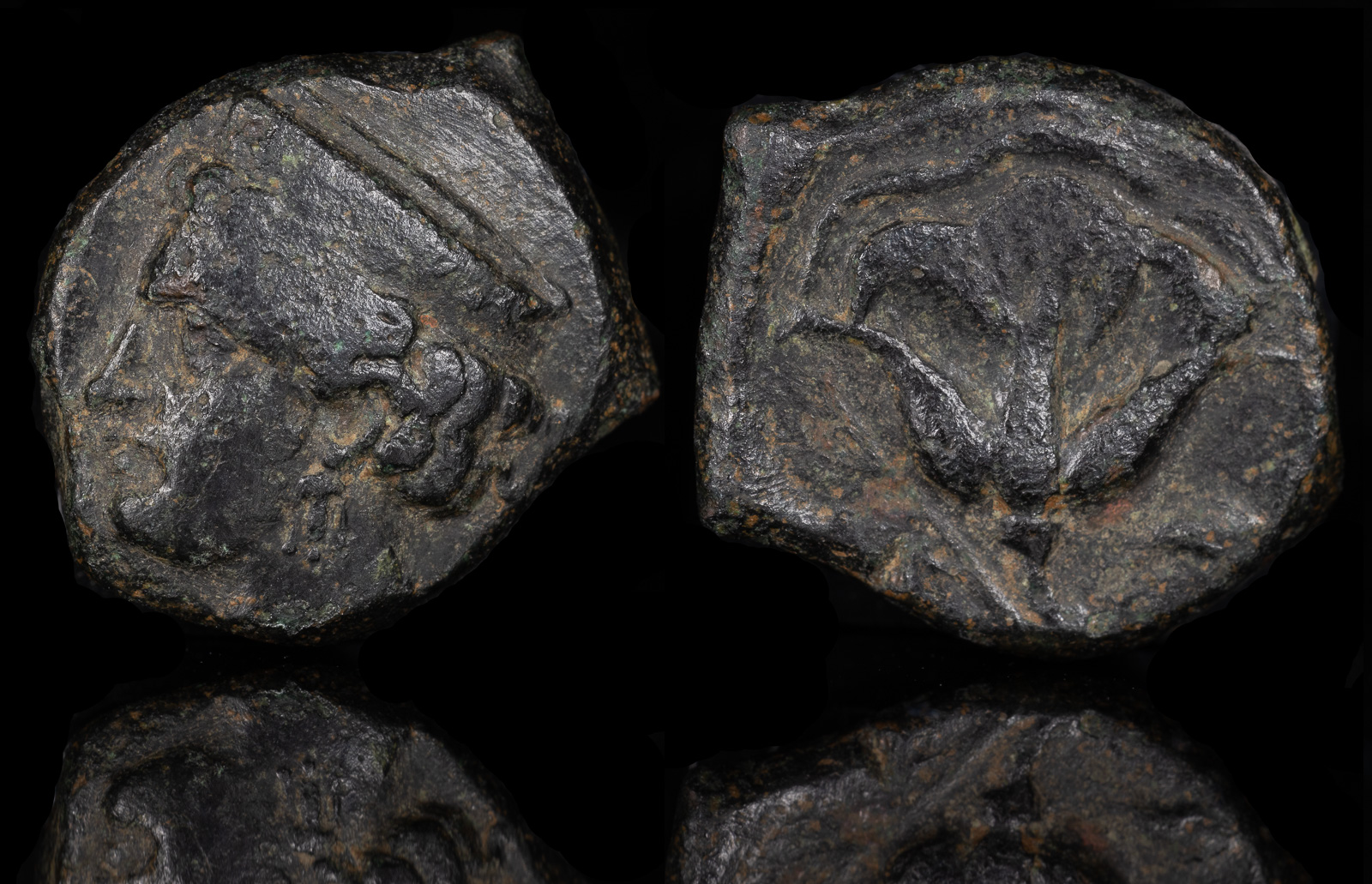
Nikokles of Cyprus
AR silver tetradrachm
Struck at Paphos, Cyprus, 325-317 BCE
Head of Herakles right, wearing lion’s skin headdress; on lion’s mane, faint letters NIKOKΛEOYΣ at the highest points (and as such worn nearly illegible).
Reverse – BAΣIΛEΩΣ AΛEΞANΔPOY Zeus seated left; holding eagle in right hand and sceptre in left; ΠΑΦ monogram for Paphos in left field, and below the throne, a laurel spring.
Price 3123. May, Paphos 7, pl. 1, 9. Tziambazis 11. Very rare. 26mm, 17.0g
As many of you know, my primary collection is attributions to specific people who played a part during the time of Philip II, Alexander III, and the Age of the Diadochi (still searching for a shorter name). At times, these attributions can be shaky, but are always based on research. Such is the case for this one.
I’d been after a coin from Nikokles of Paphos for some time. His tets, minted in the names and types of Alexander III, are famous for having “Nikokles” in tiny letters engraved into the mane. I’ve never found a great photo of the inscription, but from what I’ve read it’s so tiny that a microscope is necessary to fully distinguish it, and numismatists didn’t discover it until the late 1800’s.
So, I put him on the list and hoped I would get a shot at one. From my research, the coins are only semi-rare and those with the inscription sold for between $1k-$3k. Then, I realized two things.
First, a copy came up in an NAC auction, it was in superb condition, though as I understand the inscription was still worn (I’m not sure if there’s a copy where it’s not). The estimate was 3k and I didn’t bid, because I figured in this auction it would and – sure enough – it went for a record 20k.
Second, I located a drachm with a very similar monogram. Although Price placed the type as “somewhere in Asia Minor”, the seller stated he’d had conversations with a Cypriot archeologist, who claimed that it was regularly dug up there. He therefore attributed it to Paphos, but with a much wider date than Nikokles’ reign. I mailed the seller and asked if there was any trace of the inscription, or if there was any reason to believe it could be isolated to Nikokles’ reign, based on the strong similarities between the monograms. He replied that, upon further research, he wasn’t sure of the Paphos attribution.
After looking through examples of Nikokles’ tets, I came to the following theories.
I doubt that Nikokles placed his name on every die. My suspicion is this was just a subset, perhaps of coins meant for a specific purpose. Or, he may have thought of the idea after he’d been minting for a bit. The vast majority of Nikokles tets have no sign of the inscription. The description states that’s due to wear, but I suspect it may not have been there in the first place.
I don’t believe there’s any guarantee that the tets didn’t go past or before his reign. We know he died roughly 306 BCE, but similar types have been dated afterwards. We also don’t know when his reign began, though it was no later than 321 BCE. Therefore, I don’t believe there’s a 100% guarantee that all coins attributed to him were minted by him.
Nikokles was the son of Timarchos, who appears to have been the son of Timocharis. There was also a Charidamos, who supposedly preceded Nikokles’ reign though is poorly understood and I only found him mentioned in Heckel. Destrooper ignores him completely.
The best knowledge on these coins appears to be Destrooper and this article covers the coinage. I believe the coin above is #8 and that below #7. In terms of attributing these, Destrooper only gives (relative) certainty on an extremely rare bronze that I don’t recall ever seeing for sale with a pegasos on the reverse. That she attributes to Nikokles, but it’s very difficult to say when these bronzes were minted, other than it seems based on burial evidence that the doves may fit from Timocharis to Nikokles and the roses to either Timocharis to Nikokles.
Destrooper is uncertain whether bronzes were minted during the time of Alexander the Great, but my belief is yes based on the fact that he was fairly tolerant of mints during his lifetime and likely wouldn’t have cared about bronzes on Cyprus.
Also uncertain is whether the dove and rose types were minted at the same time, were for changes in monetary policy, or were the result of different reigns.
So, when faced with the question, I made the following call.
The only two coins I can certainly attribute to Nikokles are the pegasos bronze (which has no recorded sales) and the tets with at least traces of the inscription, which I likely won’t be able to afford.
A tet that is too worn to see the inscription may not be directly attributable to Nikokles
He likely minted bronzes during his reign, though other than the Pegasos bronzes we don’t know which ones
Therefore, I figured if I picked up the rose type, then, along with the dove, I’d have a decent shot. My suspicion is these types signal a regnal change. Since Nikokles ruled from at least 321 to 306, he had time to mint. Since the dove types have been found in tombs that definitely predate Nikokles, my guess is he minted the rose types.
Again, we’ll probably never know for sure, but I felt this enough to pick it up. It also certainly helped that no one bid on the coin, so I grabbed it.

CYPRUS, Paphos. Timarchos or Nikokles
Circa 350-320 BCE
Æ 16mm, 4.31 g, 1h
Head of Aprodite left, wearing decorated crown
Rose; in left field, branch, in right field, uncertain object (eagle’s head?)
Zapiti & Michaelidou 22; Destrooper pl. 10, 14; Tziambazis 92 var. (legend in reverse field)